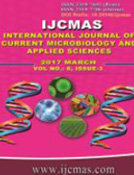


 National Academy of Agricultural Sciences (NAAS)
National Academy of Agricultural Sciences (NAAS)

|
PRINT ISSN : 2319-7692
Online ISSN : 2319-7706 Issues : 12 per year Publisher : Excellent Publishers Email : editorijcmas@gmail.com / submit@ijcmas.com Editor-in-chief: Dr.M.Prakash Index Copernicus ICV 2018: 95.39 NAAS RATING 2020: 5.38 |
Diabetic foot ulcer is one of the dreaded complications of uncontrolled diabetic mellitus, leading to consequences like gangrene and amputation of foot. This study was conducted as an endeavor to scrutinise the major genera of bacteria which were in association with the infected diabetic foot ulcers and their antibiotic sensitivity pattern. This prospective analytical study included 100 samples from diabetic foot ulcer patients. Isolation and identification of organism were done based on standard laboratory technique. Bacterial susceptibility to antibiotics was determined by Kirby Bauer disc diffusion method. Analysis of 100 samples showed 77% were culture positive and 23% were culture negative. Of 77 culture positive 60 (77.9%) were monomicrobial and 17 (22.1%) were polymicrobial. A total of 97 bacteria were isolated from 77 culture positive samples, of which 67% were gram negative and 32% were gram positive bacteria. Antimicrobial sensitivity testing showed that 61.5% of gram negative bacilli were ESBL producers and 21% of Staphylococcus aureus was methicillin resistant. In conclusion, the prevalence of MDR organisms, MRSA and ESBL producing organisms are very high in the diabetic foot patients in India because of indiscriminate use of antibiotics which necessitates the need for continuous strict surveillance of resistant bacteria.
 |
 |
 |
 |
 |